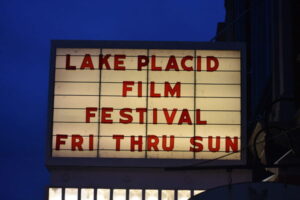by Peg Aloi

Now that we’re essentially in the third year of an ongoing pandemic, one that as of December 2022 looks like it might be surging again and with added complications from new strains of RSV, flu and who knows what else…let’s talk about the future of film festivals! I attended three film festivals in 2022 (two large international festivals and one small local festival) and I’ll be discussing my own experiences as well as my impressions of general trends. A number of film festivals canceled entirely in 2020 and 2021, but some of them adjusted to the pandemic by offering virtual options, or, in 2022, hybrid models. In 2022, a number of high-profile film festivals took place in person, including the Berlin International Film Festival, BANFF, SXSW (South by Southwest), Comic-Con, the Thessaloniki Documentary festival in Greece, as well as international festivals in Venice, Toronto, Prague, New York, Reykjavik, Tokyo, Belfast, Miami, Hong Kong, Istanbul, Sydney, Sarajevo, Glasgow, Provincetown and, that most influential of film festivals, Cannes.
Sundance held their 2020 festival as usual, since it took place before the United States closed down public events in mid-March of 2020. But in 2021, they designed a very successful virtual festival, offering a user-friendly platform that allowed virtually anyone to view films for about $18-$20 a pop. I opted for this public option, viewing (and reviewing) about six or seven films, including Ben Wheatley’s IN THE EARTH (itself a pandemic project that suggests a deadly virus is still active, and which was completed while observing protective quarantine protocols.) 2021 was a great year at Sundance (some of my favorites were MASS, CRYPTOZOO, MAYDAY and WE’RE ALL GOING TO THE WORLD’S FAIR.) In 2022, I was accredited as a film critic covering the festival and was able to view almost twenty films in just under two weeks. It’s worth noting that Sundance had originally planned to have an in-person festival for this year but at the last minute switched to online-only. I noticed some Venice attendees reported on social media that they tested positive for COVID when they got home to the USA. Venice had attracted positive attention in 2021 for requiring widespread testing and masking during their festival. The 2022 Telluride film festival also saw some critics who attended testing positive for COVID. Interestingly, both of these large festivals took place in late summer.
I made the decision to travel to attend the London Film Festival in 2021 and 2022. In October of 2021, I covered the festival entirely remotely (which has to be done from within the UK.) I stayed in a converted shepherd’s hut remodeled to a charming Airbnb with a garden right on a train line. There was a fee for access even though I had press accreditation, and the viewing windows for films was limited and difficult to adhere to (especially with jet lag.) I also attended the LFF in 2022, and the user access for accredited press was vastly improved from 2021, although there were still technical glitches accessing the films to view on my laptop. Fortunately, I was staying with a tech-savvy friend in Cambridge who was able to mirror the website from his iPad to his TV, but it took some doing! And despite the access and interface for the LFF being somewhat improved from 2021 to 2022, it was still nowhere near as straightforward and simple to use as that provided by Sundance.
Though I chose remote viewing to avoid the huge crowds, I did venture into London on one day to try and see some press screenings. However, I decided to bring my aspiring teenage filmmaker godson with me, and I wasn’t allowed to bring him to any industry screenings. We did, however, score tickets to a completely full and sold-out screening of this year’s Palme d’Or winner at the Cannes Film Festival, TRIANGLE OF SADNESS, at the elegant, opulent Royal Festival Hall right near the British Film Institute Southbank venue. This was pretty thrilling for both of us, and though I was a bit uneasy, I had just gotten my second COVID booster, and I wore a mask the whole time, making me one of roughly twenty percent of people in the audience doing the same. Yes, that was me cannonballing into the “new normal”, ignoring the fact that I had heard of a number of major film festivals being vectors for COVID infection in 2021 and 2022. I’ve somehow avoided COVID infection until now and would like to keep it that way, so traveling has been somewhat fraught, especially given the recent jettisoning of requirements for masking or negative test results in most countries.
Other festivals have been offering online and digital preview access for some time now: this is true of both large and small festivals (one notable and popular one doing this is Fantasia Film Fest.) There are even film festivals that take place entirely online. Despite having mixed experiences at some of these events, it’s caused me to ruminate on the implications not just for film festivals during the current pandemic but for digital and hybrid options going forward. What does a hybrid model mean, for critics and audiences who, for reasons of immunocompromise, physical disabilities, finances, and/or limitations of location and travel options, are unable to attend in-person? Obviously, attending in person is the best-case scenario, but in our digitally immersive age, film festivals have increasingly become virtual experiences. This has the potential to make film festivals much more accessible. But there are other barriers to attending film festival in person beyond the possibility of contracting a virus.

Film festivals can be expensive to attend, for audiences, critics and filmmakers alike. As an example, even if I got free access for press accreditation to the Toronto Film Festival, the cost of travel from upstate New York, lodging and food, even on a shoestring budget (sharing rooms, etc.) would run me well over $1000 for a week. This is considered one of the world’s top festivals at which many big-name films premiere and many smaller independent films are discovered and later celebrated among the worldwide film community. Being a freelancer and not working for any high paying outlets means that these costs are out of pocket for me. Recently I was invited to introduce a film at the small Lake Placid Film Festival. I was offered a small honorarium, a nice hotel room for two nights and a VIP pass to films and workshops, but still had to pay for travel and food. It was a small festival in a small town, but I still wore a mask to most events. And while such small festivals seem like they might be a more affordable option for some attendees, prices in tourist destinations like Lake Placid tend to be high. Still, film festivals are one way that theatres in small towns (like the Palace Theatre in Lake Placid) can continue to stay relevant and functional as streaming continues to grow as an alternative to traditional exhibition.
But the fact remains that large film festivals are still designed and executed as large money-making operations. For industry professionals, simply being employed in some aspect of film production, exhibition or distribution isn’t a guarantee of involvement with major festivals. This issue was mentioned recently on Facebook by filmmaker and film critic Kat Ellinger (who also edits the film magazine Diabolique and was featured in the folk horror documentary WOODLANDS DARK AND DAYS BEWITCHED.) Ellinger recently described what it’s like being surrounded by “middle class people” in the media industry in the UK: “While I am stressing about putting the heat on and the price of bread, I just see continuing talk of film festivals and parties and screenings. And yes, I know that might not reflect what’s happening in people’s actual lives, that social media tends to show the ‘best’ of what everyone has going on and doesn’t show you the struggles, but either way I just can’t relate to these people at all. I can’t relate to a world of film festivals or spending huge amounts of money on going to screenings. These are not my people.” Ellinger also says that film criticism itself is trending towards being dominated by more-privileged voices: “People who don’t need the money are taking up the positions for cred now.”
Perhaps more pertinent than costs for festival attendees, fees for filmmakers continue to rise. There are fees to enter a film for consideration, and usually some costs involved in attending, even if entry to the festival is included. An independent filmmaker on Twitter recently commented that the high cost of entry fees, especially for major festivals like Sundance or Telluride, means that “working class/poor filmmakers get locked out of film festivals because it’s so expensive…most filmmakers don’t have money to throw away.” This filmmaker says there is also evidence of elitism in the filmmaking community: “There’s an attitude with some as well that if you can’t afford to make a film then you shouldn’t be trying…really?” Despite digital filmmaking being accessible to more creators than the traditionally more expensive method of using film, not being able to compete alongside other filmmakers due to exorbitant costs or going into deep debt to do so remains a challenge for many independent filmmakers.
These issues of access and elitism are food for thought, and very much related to the discussion around the future of film festivals. It is undeniable that cinema is one of the primary ways in which people can learn about diverse cultures and their customs, rituals, problems and economies. But it also seems true that cinema may be approaching a point where issues of access, for attendees and creators (both necessary components), need to be addressed to allow greater artistic freedom and innovation.
